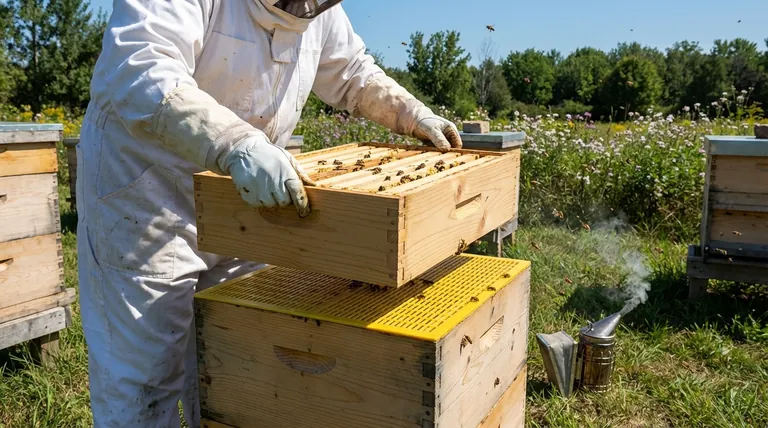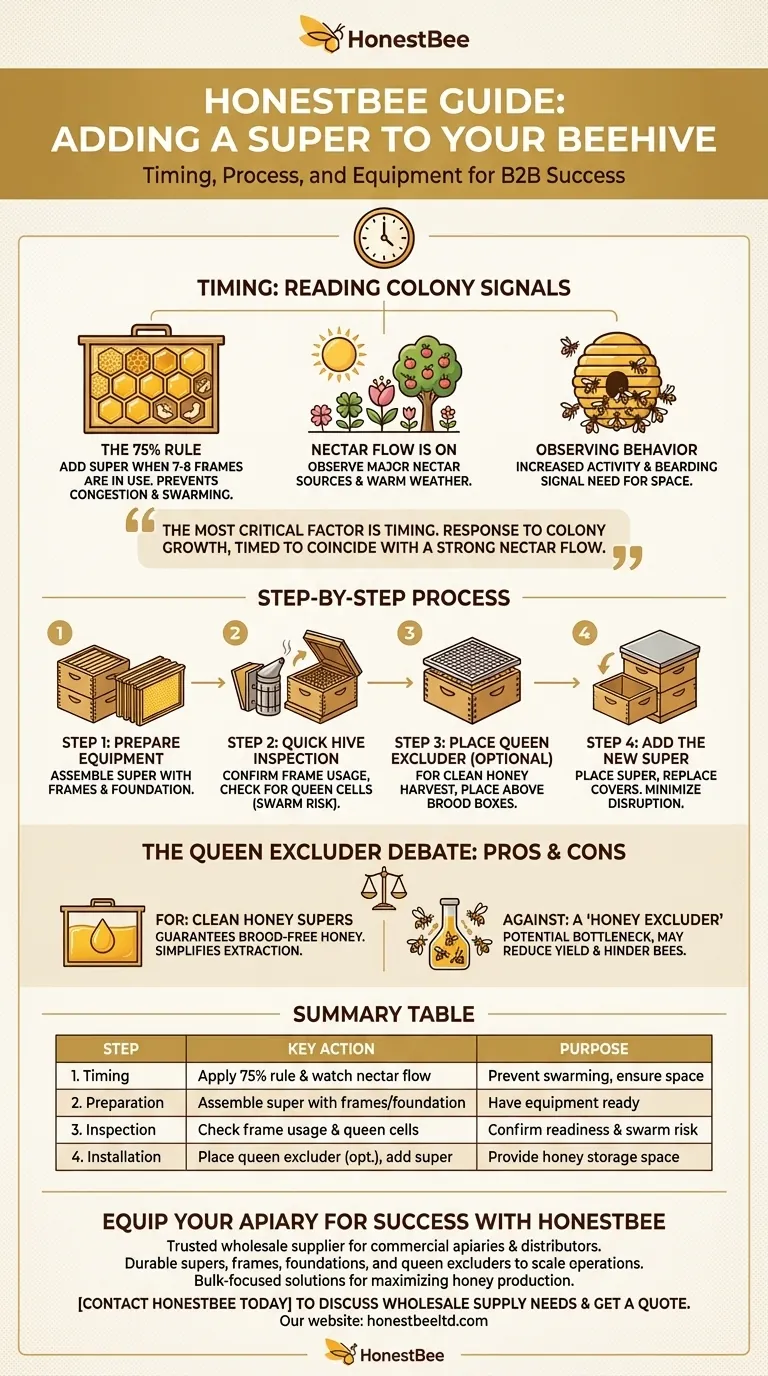Adding a super to a beehive is a straightforward process that involves preparing the new box, inspecting the colony's strength, and placing the super on top of the existing hive body. The goal is to give the colony more space for storing honey and to prevent swarming by relieving congestion. A queen excluder is often placed between the brood boxes and the new super to ensure only honey is stored in the new space.
The most critical factor in adding a super is not the physical act itself, but the timing. Adding a super is your response to the colony's growth, timed to coincide with a strong nectar flow to prevent swarming and maximize your honey harvest.

When to Add a Super: Reading the Colony's Signals
Adding a super at the right time is essential. Adding it too early can make it difficult for the bees to maintain hive temperature. Adding it too late can trigger the colony to swarm, causing you to lose a significant portion of your bees.
The 75% Rule
The most reliable internal sign is frame utilization. When the bees have drawn out comb and are using 7 or 8 of the 10 frames in the top-most box, it's time to add a super.
This indicates the hive is becoming congested and the bees will soon run out of room to store incoming nectar and expand the brood nest.
The Nectar Flow is On
Pay attention to your local environment. When you see major nectar sources like clover, fruit trees, or blackberries in full bloom, it signifies a nectar flow is underway.
This external signal, combined with favorable warm and sunny weather, means your bees will be actively foraging and will need storage space imminently.
Observing Bee Behavior
Increased activity at the hive entrance is a good indicator. If you see an unusual number of bees on the front of the hive, known as bearding, it often means the hive is overcrowded and hot inside. This is a clear sign that they need more space.
The Step-by-Step Process for Adding a Super
Once you've determined the timing is right, the physical process is simple and should be done on a calm, sunny day when most foragers are out of the hive.
Step 1: Prepare Your Equipment
Before you open the hive, have your new super ready. This means the box is assembled and filled with frames, each fitted with foundation (either wax or plastic) to guide the bees in building straight comb.
Step 2: Conduct a Quick Hive Inspection
Gently smoke the entrance and under the lid. Open the hive and inspect the top box to confirm it's as full as you suspected. This is also a good opportunity to look for queen cells, which are a definitive sign the colony is preparing to swarm.
Step 3: Place the Queen Excluder (If Used)
If your goal is to harvest honey that is completely free of eggs and brood, place a queen excluder directly on top of the uppermost brood box. This screen allows worker bees to pass through but is too small for the queen.
Step 4: Add the New Super
Gently place the new, prepared super on top of the queen excluder (or directly on the top brood box if you are not using an excluder).
Close the hive by replacing the inner cover and the telescoping outer cover. The entire process should take only a few minutes to minimize disruption to the colony.
Understanding the Trade-offs: The Queen Excluder Debate
The use of a queen excluder is a management decision with clear benefits and drawbacks. Understanding them is key to deciding what is right for your hive.
The Argument For: Clean Honey Supers
The primary benefit is guaranteeing a brood-free honey super. This simplifies the honey extraction process immensely, as you don't have to worry about removing larvae from the frames or damaging the colony's next generation.
The Argument Against: A "Honey Excluder"
Some beekeepers believe the excluder can slow down worker bees, as they have to squeeze through the grid. This can create a bottleneck, potentially reducing the speed of honey storage and the overall yield. It can also cause minor wing damage to the bees over time.
Making an Informed Choice
The decision depends on your goals. For hobbyists who prioritize easy extraction, an excluder is often worth it. For those focused on maximizing production, going without one might be preferred, even if it means being more careful during harvest.
Making the Right Choice for Your Goal
Your approach to supering should align with your primary objective as a beekeeper.
- If your primary focus is preventing swarms: Add the super as soon as the top brood box is 70-80% full to relieve congestion and give the colony a strong sense of having ample space.
- If your primary focus is maximizing honey production: Add the super just as the nectar flow begins and consider omitting the queen excluder to allow the bees the fastest possible access for depositing nectar.
- If your primary focus is simplifying honey extraction: Always use a queen excluder to ensure your honey supers contain only honey, making the harvest clean and straightforward.
By learning to read your colony's signals, you provide space at the perfect moment to ensure a healthy, productive, and thriving hive.
Summary Table:
| Step | Key Action | Purpose |
|---|---|---|
| 1. Timing | Apply the 75% rule (7-8 full frames) & watch for nectar flow. | Prevent swarming and ensure bees need the space. |
| 2. Preparation | Assemble super with frames and foundation. | Have equipment ready for a quick, efficient installation. |
| 3. Inspection | Check frame usage and look for queen cells. | Confirm the hive is ready and assess swarming risk. |
| 4. Installation | Place queen excluder (optional), then add the super. | Provide space for honey storage while keeping brood separate. |
Ready to equip your apiary for a successful season?
As a trusted wholesale supplier for commercial apiaries and distributors, HONESTBEE provides the durable, high-quality supers, frames, foundations, and queen excluders you need to scale your operations efficiently. Our bulk-focused solutions are designed to help you maximize honey production and maintain healthy colonies.
Contact HONESTBEE today to discuss your wholesale beekeeping supply needs and get a quote.
Visual Guide

Related Products
- Professional Plastic Queen Excluder for Modern Beekeeping
- Wooden Queen Bee Excluder for Beekeeping
- High Performance Plastic Queen Excluder for Beekeeping and Apiary Management
- 8-Frame Electric Self-Reversing Honey Extractor Spinner for Commercial Honey Extraction Equipment
- HONESTBEE 6 Frame Three Use Electric Honey Extractor for Beekeeping
People Also Ask
- What are the main advantages of using a queen excluder in beekeeping? Simplify Hive Management & Harvest
- Why are queen excluders recommended for Flow Hives? Prevent Brood Damage for a Clean Harvest
- What are the pros of using a queen excluder? Boost Hive Control & Honey Quality
- What are the pros of using queen excluders? Boost Honey Production & Hive Efficiency
- How does a queen excluder work? Master Hive Management for Pure Honey Harvests



















